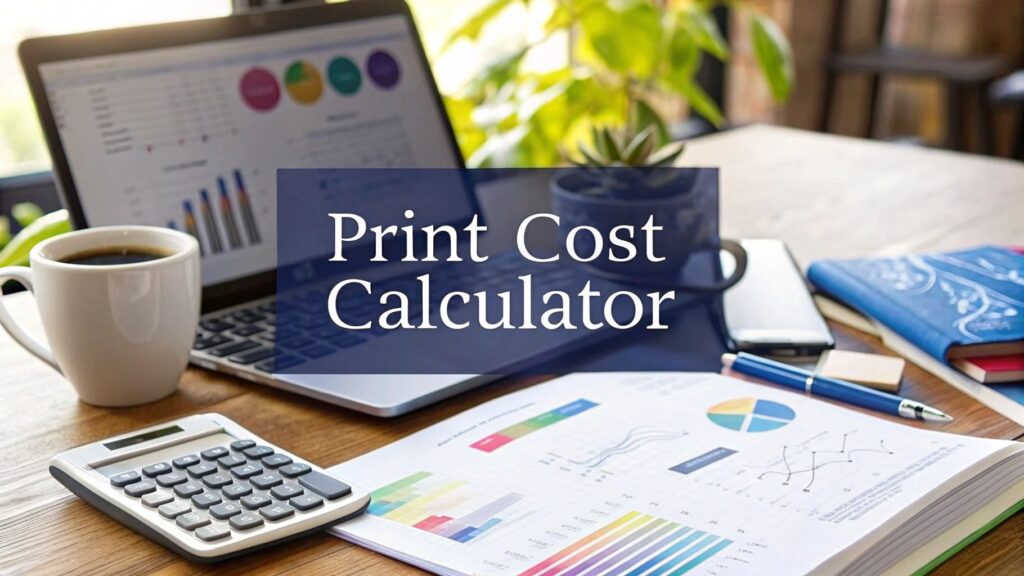What Really Drives Your Book Printing Costs
Let's talk book printing. It's not as simple as it might seem. Hidden costs can really catch you off guard, especially if you're new to this whole publishing game. I've picked up a few things over the years, chatting with seasoned publishers and print shop owners. Trust me, you don't want to repeat their budget horror stories.
One big one is the setup fee. Some printers hit you with a big upfront charge, while others bake it into the per-book price. This can make a world of difference, particularly if you're only printing a small batch. Then there are color corrections. If your files aren't perfectly print-ready, those costs can snowball fast. And binding? Oh boy. Picking the wrong binding—spiral versus perfect bound, for example—can drastically alter your bottom line.
How many copies you order also matters…a lot. You might think ordering 500 copies is simply double the cost of 250. Nope. Printing benefits from economies of scale. The per-book price usually goes down as your order size goes up. Even tiny things like the book's dimensions (trim size) or the thickness of the paper (paper weight) can ripple through your budget. Knowing what impacts cost is the first step, and you can get a good overview of related expenses in this article about Self Publishing Costs.
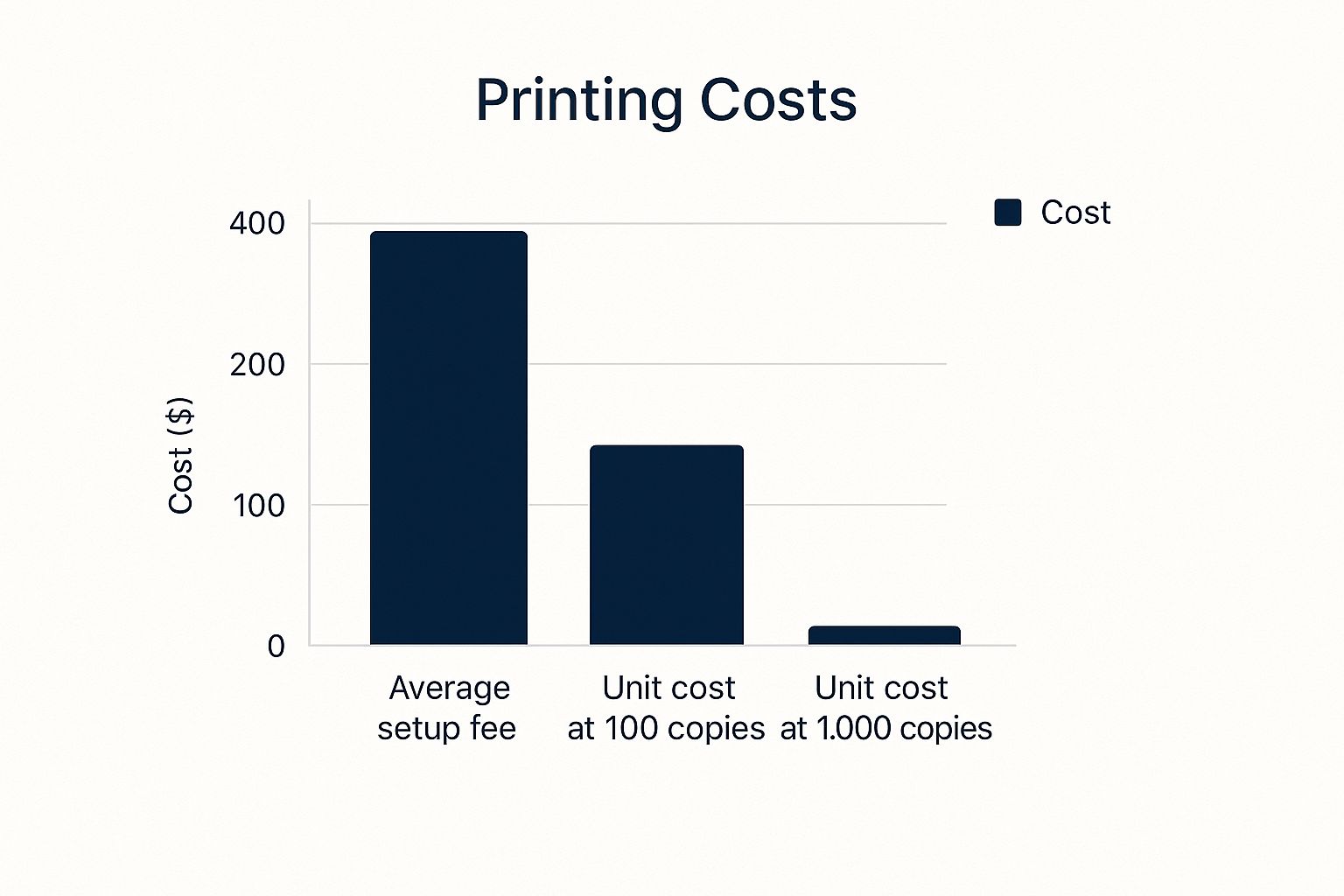
This infographic compares the average setup fee for a print run with the unit cost of printing 100 copies and 1,000 copies.
Look at that infographic. For smaller print runs, that initial setup fee is a huge chunk of the total cost. But as you print more, the setup fee's impact shrinks, and the per-book price takes center stage. Notice the big price drop per book when you jump from 100 to 1,000 copies. A key factor here is the shift from old-school offset printing to digital and inkjet printing. This has been a game-changer for smaller print runs. For example, printing 1,000 books via offset might have set you back $3–$5 per book ten years ago. Now, thanks to digital printing and print-on-demand, short runs can be as low as $2–$4 per book, and even less per book when ordering in bulk. Want to dive deeper? Check out this market report. And while you're at it, you might find this helpful: how to get an ISBN for your book.
Digital vs. Offset Printing: A Quick Look
To help you visualize the cost differences between digital and offset printing, I've put together a handy comparison table. It breaks down the costs based on different print quantities and helps you determine the best approach for your project.
| Print Quantity | Digital Cost Per Book | Offset Cost Per Book | Best Choice |
|---|---|---|---|
| 100 | $4.50 | $7.00 | Digital |
| 500 | $3.00 | $4.00 | Digital |
| 1,000 | $2.50 | $2.75 | Offset |
| 5,000 | $2.00 | $1.50 | Offset |
| 10,000 | $1.75 | $1.00 | Offset |
As you can see, digital printing tends to be more cost-effective for smaller quantities, while offset printing becomes the better option as your print run increases. This is due to the higher setup costs associated with offset printing.
A book printing cost calculator can be a useful tool, but don't rely on it blindly. You really need to understand the factors behind those numbers to get the most bang for your buck.
Getting Real Numbers From Your Calculator
Most people look at book printing cost calculators and think they’re magic. Enter some numbers, and boom – you’ve got your price. Sadly, it's not that straightforward. I remember talking to a publisher who lost a fortune on her first print run because she’d put the wrong info into the calculator. So, before you even think about using a calculator, let's talk about getting the right numbers in the first place.
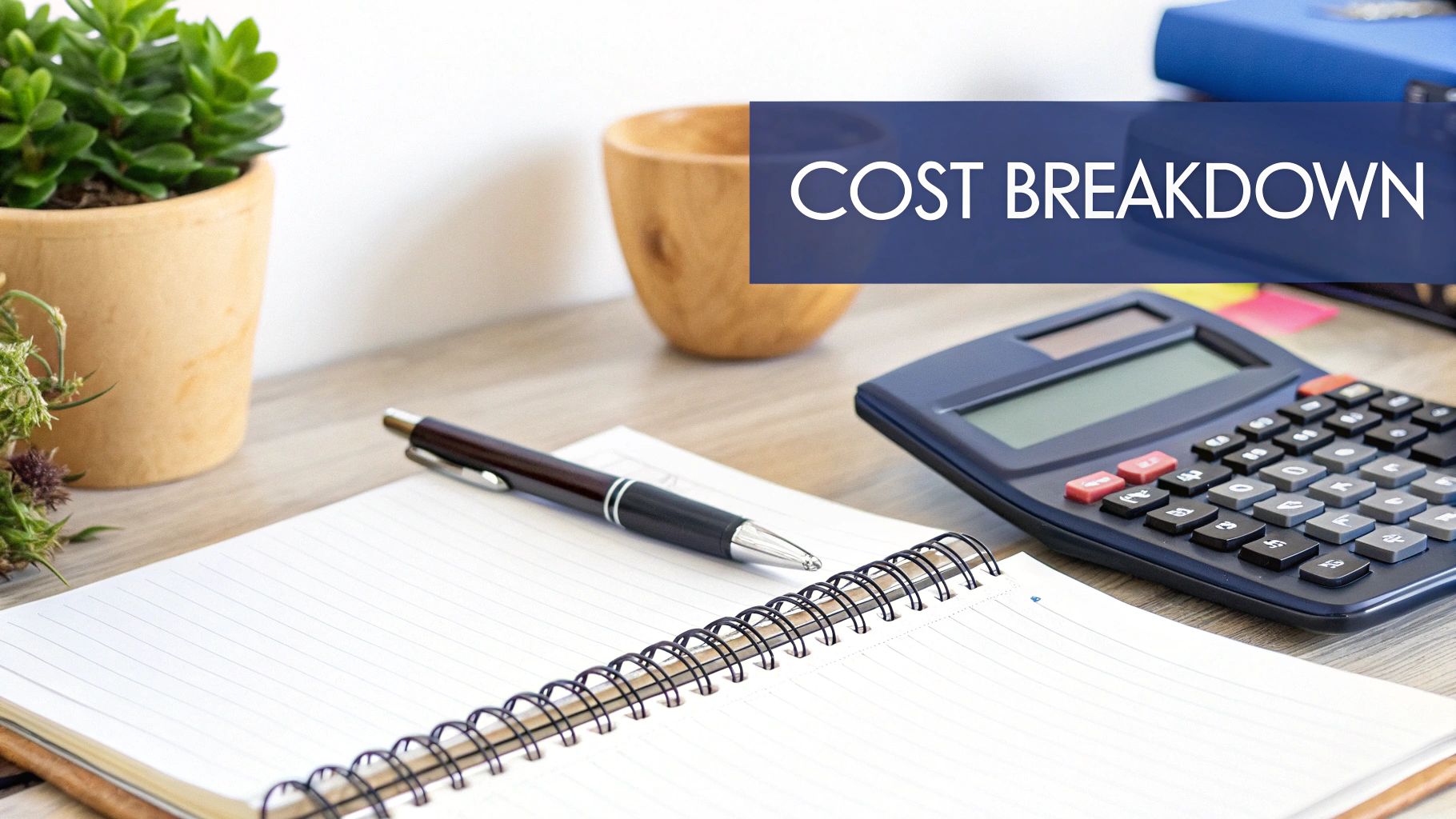
A typical book printing cost calculator, showing just how much information it needs.
Look at all those options – trim size, paper type, binding style, page count. They all matter. Each one has a real impact on your final cost. Understanding the pricing structure is key, and you can find a helpful breakdown on Pricing.
Beyond the Basics: Hidden Costs
It's not just the obvious stuff, either. Think about paper grain direction. It affects how your book lays flat and how well the binding holds up. Then there are the binding margins. Too small, and your text gets swallowed by the spine. Cover finishes – matte, gloss, or something more exotic – add another layer of cost. Every decision adds up.
The Big Impact Variables
Some choices have a bigger impact than others. Page count is a clear one. But so is color. Full-color printing costs way more than black and white. Hardcovers are more expensive than paperbacks, too. These are the areas where small changes can really swing the price.
Estimating vs. Knowing
Some things you can estimate (like initial sales – you never really know). But other things you need to be precise about. Don’t guess your trim size – measure it. Don’t estimate your page count – count it. Accuracy here saves you a lot of grief later on.
The Forgotten Factors
Most calculators focus only on the direct cost of printing. They forget things like reprints, rush orders, and – crucially – shipping. These can really add up, especially for big print runs. I’ve seen publishers get slammed with huge shipping bills they weren't expecting, and it wipes out their profits. Factor these hidden costs in right from the start. Trust me, learning from other people’s mistakes is much better than making them yourself, especially when it comes to your hard-earned cash.
Timing Your Print Run Like a Pro
Let’s be honest, printing a book can be a pricey endeavor. But savvy publishers know a secret: book printing costs aren’t set in stone. They fluctuate based on all sorts of market forces, from paper shortages and energy prices to seasonal demand and even global shipping hiccups. These seemingly small factors can easily impact your bottom line by hundreds, or even thousands, of dollars. That's where smart timing comes in.
I've seen firsthand how experienced publishers closely monitor these patterns to optimize their print runs. Imagine shaving a significant amount off your budget simply by printing at the right time. It's totally doable! For example, during the recent paper shortage, some publishers weathered the storm by tweaking their schedules and exploring different paper options. Others adapted to supply chain disruptions by building flexibility into their project timelines and maintaining close communication with their printing partners. These weren't always easy calls, but they were crucial for staying profitable when others weren’t. Speaking of shipping, for larger books, those costs can really add up. Using a Dimensional Weight Shipping Calculator can help you get a handle on that.
Recognizing the Market Signals
So how can you anticipate these cost fluctuations? It starts with recognizing the warning signs. News about mill closures or rising pulp prices, for instance, can hint at a looming paper shortage. Keeping tabs on industry publications and printer newsletters can give you those early insights. Trust me, it pays to be in the know.
Market trends and overall economic conditions also play a huge role in book printing costs. These costs are directly tied to raw material prices, labor dynamics, and the adoption of new technologies. While the global book market is projected to grow, there's still a lot of volatility. In 2023, for example, printed book volumes actually decreased, impacting the cash flow of both printers and publishers. You can find more about that here. It's a good reminder that you can’t just look at the big picture; you have to dig a little deeper.
Also, don’t forget about seasonal trends. Printers are often swamped leading up to major holidays, which can translate into higher prices and longer lead times. Planning your print run outside of these peak periods can save you a bundle.
Developing a Flexible Strategy
One of the most important things you can do is build a flexible timeline. This might involve having a backup printer in mind or simply padding your schedule to allow for potential delays. You might also want to check out this article on how long it takes to publish a book. Having a contingency plan is like having an insurance policy for your project; it allows you to adapt to unexpected market shifts without completely derailing your plans.
Finally, remember that printers adjust their pricing based on demand. Understanding these pricing strategies can give you a real edge when it’s time to negotiate. And building a solid relationship with your printer? That can open doors to better rates and more flexible options down the line. By staying informed and taking a strategic approach, you can transform timing from a potential source of stress into a powerful cost-saving tool.
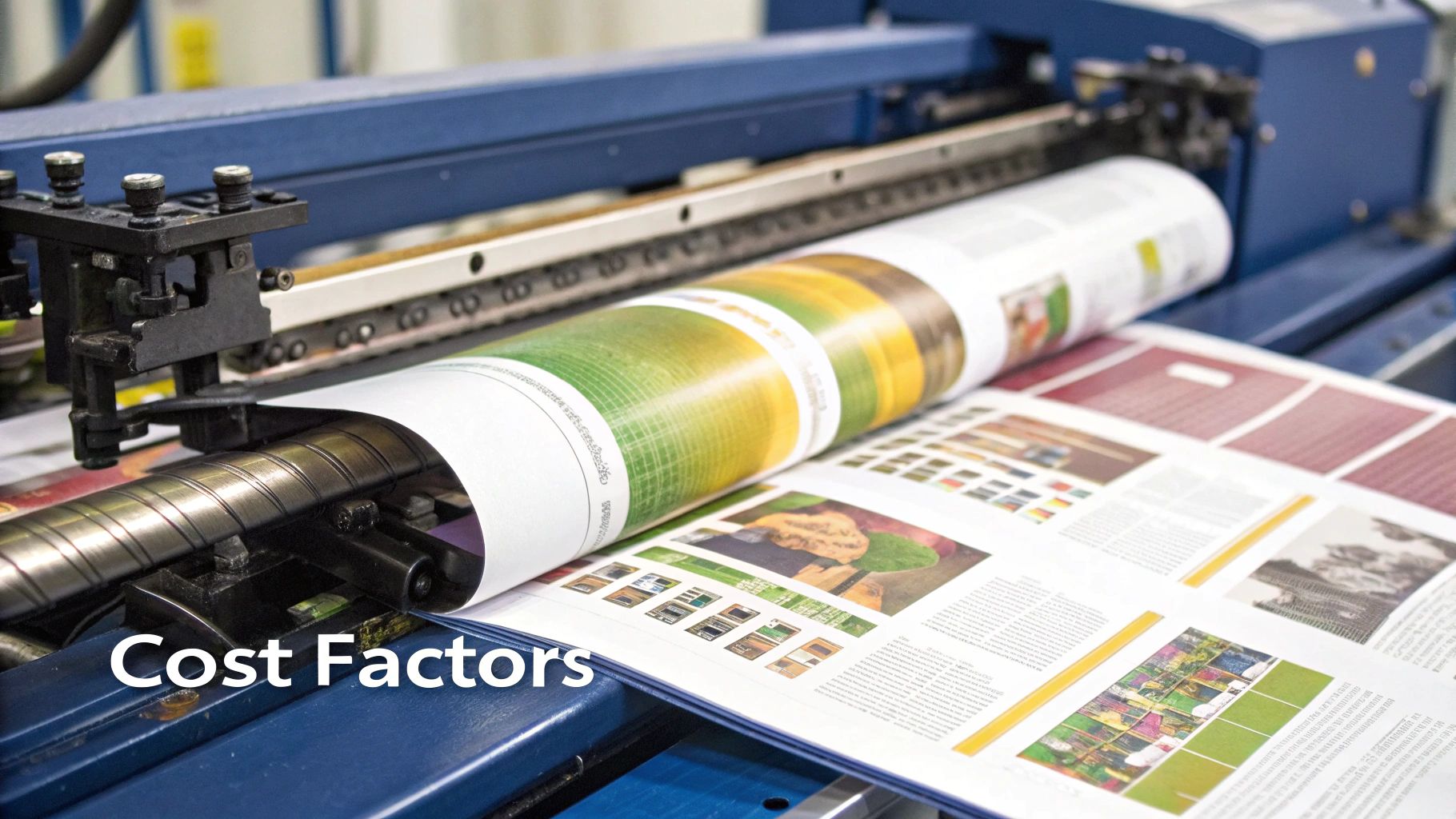
How Modern Technology Changes Everything
The printing industry is changing. Quietly, behind the scenes, the way we calculate book printing costs is being completely reshaped. Think about it: automation, AI-driven processes, and seriously advanced printing tech are becoming standard. These aren't just trendy terms; they're causing real, tangible shifts in how efficient printing is, how much waste is produced, and even what kind of customization options are available. And that has a huge impact on your bottom line when printing a book.
Let me give you an example. Many modern print shops use AI to predict and fix color variations before they become a costly nightmare. I've seen firsthand how a small color shift could once lead to thousands of dollars down the drain. Now, clever algorithms catch these issues early, saving everyone time, money, and stress. Similarly, automated systems are slashing setup times. Less manual work means lower labor costs, which means a better quote for you.
These advancements also make small print runs way more affordable. Remember when printing just a few hundred copies was basically impossible for independent authors? Not anymore. Digital printing combined with automation makes shorter runs realistic, even for those on a tight budget. And let's talk about customization. Forget limited options! New technology opens up a world of personalized touches that used to be out of reach for most independent publishers. This directly affects how a book printing cost calculator works – giving you far more accurate estimates.
The Impact of AI and Automation
The rise of AI-driven and automated printing technologies is transforming how book printing cost calculators estimate expenses. They’re making printing less wasteful, more efficient, and way more personal. By 2025, it's predicted that up to 15% of commercial printers will use AI-driven processes to optimize print quality and efficiency. Some estimates even suggest these technologies can cut setup times by 30% and reduce ink and paper waste by as much as 20%. Want to dive deeper into these trends? Check out these printing industry statistics. This increased efficiency translates directly into lower costs, and smart print shops are passing those savings along to authors.
Getting the Best Price for Your Book
So, when you're using a book printing cost calculator, don't be afraid to ask potential printers about their technology. Do they use AI-powered color correction? What kind of automation do they have in place? Asking these questions can uncover hidden cost savings that you won't see in a standard quote. It's like knowing the secret menu at your favorite restaurant; you unlock options that most people miss! By understanding how technology is changing printing, you can use these innovations to your advantage and get the very best price for your book.
Proven Strategies For Cutting Your Printing Costs
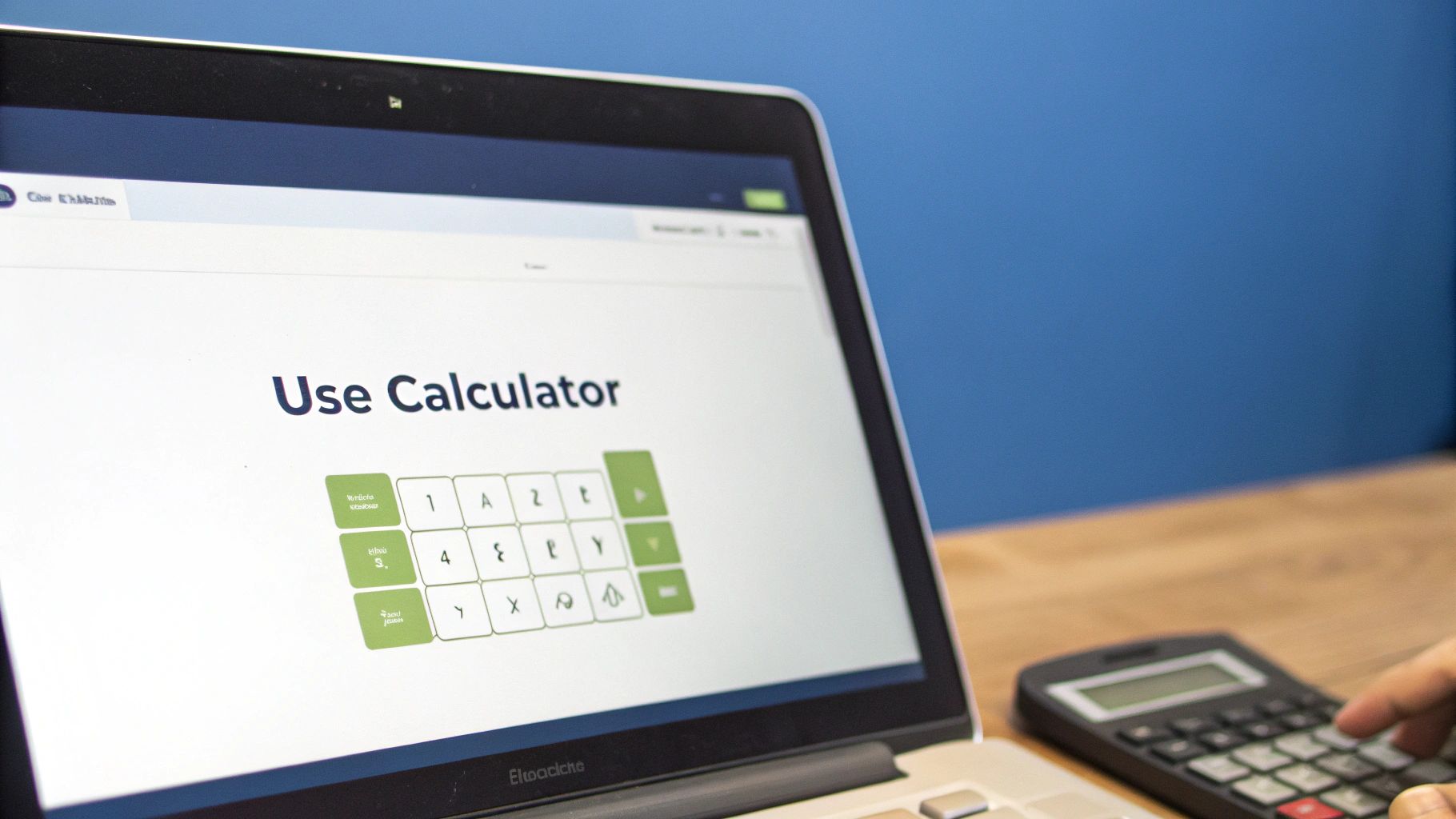
A book printing cost calculator is helpful, sure. But it's really just a first step. Experienced publishers know the real work begins after that initial number pops up. They've got a whole bag of tricks for bringing costs down without making the final product look cheap. It's all about smart compromises: knowing where to save and where to splurge for the best result.
Optimizing Your Book Design for Cost
Book design has a huge impact on your printing costs. I learned this the hard way. When I first started publishing, I didn’t realize how seemingly small design decisions could make such a difference. Things like margins, fonts, and image placement can seriously affect your final bill. Wider margins mean fewer words per page, which can bump up your page count (and therefore the price). Unusual or decorative fonts can sometimes require special printing, adding extra expense. Thinking carefully about where you put images can also help minimize color printing, which is great if you’re on a tight budget.
The Power of Group Printing
Group printing is another game-changer. Teaming up with other authors or publishers to print together can unlock some great discounts. Think of it like buying in bulk – you get a lower price per unit when you order larger quantities. This is especially helpful for smaller print runs, where the initial setup costs make up a bigger chunk of the overall price.
Building Relationships and Negotiating
Never underestimate the importance of building relationships. A good rapport with your printer can lead to better rates in the long run and give you more flexibility. In my experience, printers are often open to negotiation, especially if you're willing to commit to larger print runs or become a regular client. This is where truly understanding your book printing cost calculator results is key. You can use that data as leverage to ensure you’re getting a reasonable deal. Want to delve deeper into publishing expenses? Check this out: Read also: Cost to Publish a Book.
Creative Financing for Larger Print Runs
Financing a big print run can be tricky, particularly for independent authors. That's when you need to get creative. I've seen authors run successful pre-order campaigns to cover printing costs, essentially letting their readers invest in the project. Others have teamed up with businesses or organizations to share the financial load. Looking into these less conventional financing options can help you manage your cash flow and lower the financial risk.
Cost-Saving Strategies and Their Impact
To help visualize the impact of different cost-saving measures, I’ve put together a table summarizing some key strategies, their potential savings, how difficult they are to implement, and their potential effect on quality.
| Strategy | Potential Savings | Implementation Difficulty | Quality Impact |
|---|---|---|---|
| Reduce Margins | 5-15% | Easy | Minimal |
| Use Standard Fonts | 2-5% | Easy | Minimal |
| Optimize Image Placement | 5-10% | Medium | Minimal |
| Group Printing | 10-25% | Medium | None |
| Negotiate with Printer | 5-15% | Medium | None |
| Pre-Order Campaign | Varies | Hard | None |
| Partnerships | Varies | Hard | None |
Using these strategies helps you take charge of your printing budget and make smart choices that are good for both your wallet and the quality of your book. The goal isn’t to find the cheapest option; it’s to find the smartest one.
Avoiding The Expensive Mistakes Everyone Makes
So, you're ready to print your book? Even with a handy book printing cost calculator and a well-laid plan, there are some common pitfalls that can really throw a wrench in the works (and your budget!). Let me share a few stories from the trenches – mistakes I've seen publishers make that cost them time, money, and a whole lot of stress.
I was talking to a publisher recently who told me about a simple PDF export setting that ended up adding $800 to her printing bill. It caused a chain reaction: corrections, delays, and reprints. It’s a perfect example of how seemingly minor technical glitches can snowball into big expenses.
Another thing I see all the time is publishers underestimating shipping costs. Think about it: shipping a few boxes is one thing, but when you're dealing with hundreds or thousands of books, those costs really add up. I’ve seen publishers completely forget about shipping until they get the final invoice – and that’s never a pleasant surprise.
Common File Format Issues
Most printers have very specific requirements for file formats. If your files don’t match those specs, you’re looking at potential delays and extra charges. A really common problem is submitting files in the wrong color mode (like RGB instead of CMYK). This seems minor, but it can cause noticeable color shifts during printing, meaning you might have to reprint the whole thing – ouch!
The Importance of Contingency Planning
Let's face it, unexpected things will happen. Reprints, corrections, rush orders – these are all possibilities. The best way to handle these surprises is to build some wiggle room into your budget and timeline. I recommend adding 10-15% to your printing budget just for contingencies. Trust me, it's worth it.
Communication is Key
Talk to your printer! Don't be shy. Discuss your expectations upfront, ask questions, and make sure you're both on the same page about things like file formats and color specifications. Misunderstandings can be costly, and it’s always easier and cheaper to iron out the details beforehand.
Setting Realistic Expectations
Printing a book takes time. There will be hiccups. Rushing the process almost always leads to errors and drives up costs. I know a publisher who made a last-minute design change and ended up paying an extra $500 for expedited printing. Careful planning and open communication with your printer are the best ways to avoid those surprise expenses.
Learning From Others’ Mistakes
Honestly, the best way to avoid these costly errors is to learn from others who've been there. Talking to other publishers who've learned these lessons the hard way can be incredibly valuable. Focus on creating contingency plans, building realistic buffers into your budget, and communicating effectively with your printer. These are the keys to a smooth printing process, from the initial quote to the final delivery.
Your Complete Action Plan For Accurate Pricing
Putting together a realistic budget for printing your book shouldn’t feel like throwing darts blindfolded. Think of it like building a house: you need a solid blueprint before you even think about picking up a hammer. This action plan will walk you through the process, from those first rough estimates to getting those final quotes.
Pre-Calculation Checklist: Gathering Essential Information
Before you even look at a book printing cost calculator, there are a few must-haves you need to gather. Seriously, don’t skip this part. It’s like forgetting the flour when baking a cake – it just won’t work!
- Trim Size: Don’t eyeball it, measure it! Even a small difference in trim size can change your printing costs.
- Page Count: This one's critical. Every page adds to the expense, so get an accurate count.
- Binding Style: Perfect bound, spiral, saddle-stitched… each binding option has its own price tag. Understanding these differences is key.
- Paper Type and Weight: Your paper choice makes a huge impact, both on the final cost and how the book feels in your hands. Do your research!
- Cover Finish: Matte, gloss, or something fancy? This all needs to be factored into your budget.
Key Questions to Ask Your Printer
Don’t be afraid to ask your printer lots of questions! It’s their job to help you understand the process. Asking these questions can uncover hidden costs before they become unpleasant surprises:
- Setup Fees: Are there any, and if so, how much?
- Proofing Costs: How much will proofs cost, and how many rounds are included in the initial quote?
- Color Corrections: If your colors need tweaking, what’s the charge?
- Shipping and Handling: This one can really sneak up on you. Get clear shipping quotes upfront.
Warning Signs: When to Reassess Your Estimates
Sometimes things just don’t add up. Here are a few red flags that should make you pause and reassess:
- Quotes Significantly Higher Than Expected: If a quote is way off from your initial estimates, something’s not right. Double-check everything for hidden costs or misunderstandings.
- Vague Pricing: If a printer is hesitant to give you clear, itemized pricing, that’s a big red flag.
- Unrealistic Turnaround Times: If something sounds too good to be true, it probably is. Be realistic about timelines.
Building Your Timeline and Budget
Think realistically about how long your project will actually take. Factor in extra time for potential hiccups – trust me, there are always hiccups! Create a budget spreadsheet that includes everything, not just the printing costs. Think about reprints, corrections, and even marketing materials.
By following this plan, you’ll feel much more confident about your cost estimations and avoid those budget-busting surprises. And building a good relationship with your printer? That’s worth its weight in gold. It’ll help you navigate the entire process smoothly and keep your book project on track. Ready to start your publishing journey? Visit BarkerBooks for expert guidance and a seamless publishing experience.
